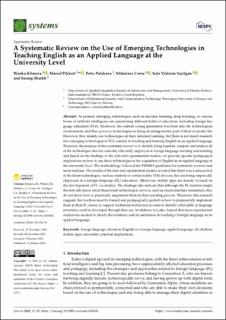| dc.description.abstract | At present, emerging technologies, such as machine learning, deep learning, or various forms of artificial intelligence are penetrating different fields of education, including foreign language education (FLE). Moreover, the current young generation was born into the technological environment, and they perceive technologies as being an indispensable part of their everyday life. However, they mainly use technologies in their informal learning, but there is not much research into emerging technologies in FLE, namely in teaching and learning English as an applied language. Therefore, the purpose of this systematic review is to identify, bring together, compare and analyze all of the technologies that are currently efficiently employed in foreign language teaching and learning, and based on the findings of the detected experimental studies, we provide specific pedagogical implications on how to use these technologies in the acquisition of English as an applied language at the university level. The methodology followed the PRISMA guidelines for systematic reviews and meta-analyses. The results of the detected experimental studies revealed that there was a serious lack of the latest technologies, such as chatbots or virtual reality (VR) devices, that are being empirically employed in a foreign language (FL) education. Moreover, mobile apps are merely focused on the development of FL vocabulary. The findings also indicate that although the FL teachers might theoretically know about these latest technological devices, such as neural machine translation, they do not know how to practically implement them in their teaching process. Therefore, this research suggests that teachers must be trained and pedagogically guided on how to purposefully implement them in their FL classes to support traditional instruction in order to identify what skills or language structures could be developed through their use. In addition, it is also claimed that more experimental studies are needed to clearly the evidence and its usefulness in teaching a foreign language as an applied language. | en_US |

